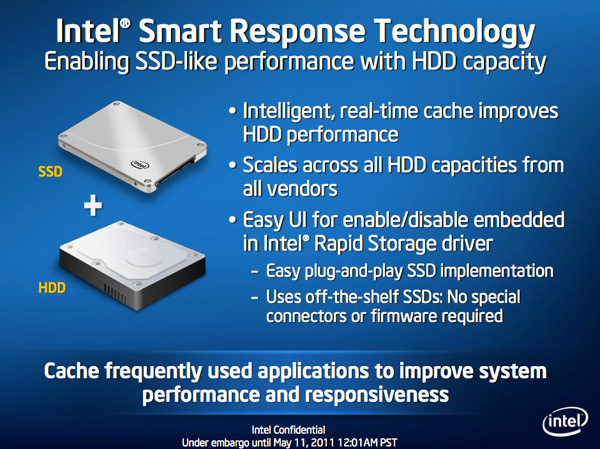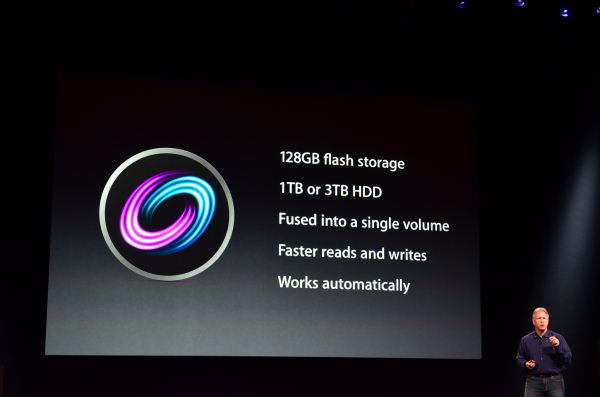A Month with Apple's Fusion Drive
by Anand Lal Shimpi on January 18, 2013 9:30 AM EST- Posted in
- Storage
- Mac
- SSDs
- Apple
- SSD Caching
- Fusion Drive
When decent, somewhat affordable, client focused solid state drives first came on the scene in 2008 the technology was magical. I called the original X25-M the best upgrade you could do for your system (admittedly I threw in the caveat that I’d like to see > 100GB and at a better price than $600). Although NAND and SSD pricing have both matured handsomely over time, there’s still the fact that mechanical storage is an order of magnitude cheaper.
The solution I’ve always advocated was a manual combination of SSD and HDD technologies. Buy a big enough SSD to house your OS, applications and maybe even a game or two, and put everything else on a RAID-1 array of hard drives. This approach works quite well in a desktop, but you have to be ok with manually managing where your files go.
I was always curious about how OEMs would handle this problem, since educating the masses on having to only put large, infrequently used files on one drive with everything else on another didn’t seem like a good idea. With its 6-series chipsets Intel introduced its Smart Response Technology, along with a special 20GB SLC SSD designed to act as a cache for a single hard drive or a bunch in an array.

Since then we’ve seen other SSD caching solutions come forward that didn’t have Intel’s chipset requirements. However most of these solutions were paired with really cheap, really small and really bad mSATA SSDs. More recently, OEMs have been partnering with SSD caching vendors to barely meet the minimum requirements for Ultrabook certification. In general, the experience is pretty bad.
Hard drive makers are working on the same problem, but are trying to fix it by adding a (very) small amount of NAND onto their mechanical drives. Once again this usually results in a faster hard drive experience, rather than an approximation of the SSD experience.
Typically this is the way to deal with hiding latency the lower you get in the memory hierarchy. Toss a small amount of faster memory between two levels and call it a day. Unlike adding a level 3 cache to a CPU however, NAND storage devices already exist in sizes large enough to house all of your data. It’s the equivalent of having to stick with an 8MB L3 cache when for a few hundred dollars more you could have 16GB. Once you’ve tasted the latter, the former seems like a pointless compromise.
Apple was among the first OEMs to realize the futility of the tradeoff. All of its mainstream mobile devices are NAND-only (iPhone, iPad and MacBook Air). More recently, Apple started migrating even its professional notebooks over to an SSD-only setup (MacBook Pro with Retina Display). Apple does have the luxury of not competing at lower price points for its Macs, which definitely makes dropping hard drives an easier thing to accomplish. Even so, out of the 6 distinct Macs that Apple ships today (MBA, rMBP, MBP, Mac mini, iMac and Mac Pro), only two of them ship without any hard drive option by default. The rest come with good old fashioned mechanical storage.
Moving something like the iMac to a solid state configuration is a bit tougher to pull off. While notebook users (especially anyone using an ultraportable) are already used to not having multiple terabytes of storage at their disposal, someone replacing a desktop isn’t necessarily well suited for the same.

Apple’s solution to the problem is, at a high level, no different than all of the PC OEMs who have tried hybrid SSD/HDD solutions in the past. The difference is in the size of the SSD component of the solution, and the software layer.










127 Comments
View All Comments
guidryp - Friday, January 18, 2013 - link
These claims about the effort in setting up SSD/HD combo are getting quite silly.There is essentially ZERO time difference into setting up SSD/HD partitioned combo vs Fusion. Your payback would be on Day 1.
The only effort is simply deciding which partition to load new material on. That decision takes what? Microseconds.
It is as simple as install OS/Apps on SSD, Media HD. Vs Install OS/Apps/Media on Fusion. The effort is essentially the same.
But that simple manual partition will perform better, create less system thrashing and less wear on all your drives.
Zink - Friday, January 18, 2013 - link
But then you end up with a SSD filled up with no longer relevant data and you need to figure out how to free up space again. A combo drive takes care of that for you and keeps the SSD filled to the brim with most of the data that gets used. You can download any games, start any big video editing project, and know that you are getting 50%-100% of the benefit of the SSD without worrying about managing segregated data. With a segregated setup you end up playing games from the HDD or editing video files that are on the HDD and sometimes see 0% of the benefit of the SSD. Fusion seems like the future.KitsuneKnight - Friday, January 18, 2013 - link
If you can divide your data up as OS, Apps, and Media, and OS + Apps fits on the SSD, then sure, it's not too bad.Unfortunately, my Steam library is approximately 250 GBs... That alone would fill up most SSDs out there. And that's not even counting all my non-Steam games, which would help push most any SSD towards being totally full. If I'd bought too many recent games, it'd likely be quite a bit larger than that (AAA games seem to be ranging from 10-30 GBs these days).
Unless you sprung for a 500 GB SSD (which aren't exactly cheap, even today), you'd be having quite a pickle on your hands. Likely having to move most of the library manually to the HDD (which is a bit of a pain with Steam). Which means it's suddenly much more complicated than OS/Apps on SSD, and Media on the HDD. Especially since SSDs massively improve the load time of large games (unlike the impact it has on media).
And then there's the other examples I've already given: the artist I know that works on absurdly massive PSDs, and has many terabytes of them (what's the point of a SSD if it doesn't benefit your primary usage of a computer?), as well as my situation with VMs on my non-gaming machine (which actually has a SSD + HDD setup right now). A lot of people could probably do the divide you're talking about, but likely even more people could fit all their data in either a 128 or 256 GB SSD.
name99 - Friday, January 18, 2013 - link
Then WTF are you complaining about?You can still buy an HD only mac mini and add your own USB3 SSD as boot disk.
Or you can buy a fusion mac mini and split the two drives apart.
It's not enough that things can be done your way, you ALSO want everyone else, who wants a simple solution, to have to suffer?
Mr Perfect - Friday, January 18, 2013 - link
Intel SRT is useful for everyone, there's no reason to look down on it. Could I sit there and manually move files back and forth between the SSD and HD? Sure. But why? Seriously, I have better things to do with my time then move around the program of the week between storage mediums. Last week I was using Metro 2033, this week is World of Tanks. Next week I might finish one of those run throughs of D:HR or Portal 2 that I left hanging. SRT takes care of all of that. This is 2013, an enthusiast class workstation should damn well be able to handle something as simple as caching, and it can. Enterprise class servers have been doing it for some time, so why isn't it good enough for a gameing rig?My one complaint with RST is the cache size limit. Why would Intel even impose a limit?
EnzoFX - Saturday, January 19, 2013 - link
You're framing it in your own way so that only your solution works. Fail. Unnecessary stressing of the SSD? The better argument for most people would be putting that SSD to good use. Not trying to NOT use it.It further isn't simply about putting the files where they go, and then be done with. Files are changed, updated, and if you're on multiple drives, copied back and forth. Some people don't want to deal with that. Actually, no one should want to do deal with that. There are only barriers with every person having their own thresholds to good solutions. Is it that hard to understand?
lyeoh - Saturday, January 19, 2013 - link
Do you manually control the data in the 1st, 2nd level cache in your CPU too? There are plenty of decent caching algorithms created by very smart people. If the algorithms were that bad your CPU would be running very slow.There should be no need for you to WASTE TIME moving crap around from drive to drive. The OS can know how often you use stuff, and whether the accesses are sequential, random, slow.
If Windows 8's Storage Spaces was more like Fusion Drive out of the box (or better even), us geeks would be more impressed by Windows 8.
Feldur - Monday, June 29, 2015 - link
Having designed and built both computers and operating systems, I qualify as not naive. I'm interested in your assertion, therefore, that because I prefer letting the Fusion drive do the work that I must be lazy. You're making a judgement about how I should spend my time - that it's the best investment of my time to shuffle files about (non-trivial if I want the level of granularity a Fusion drive can offer, too) versus developing software or playing with my dog. It's interesting that you think you know me that well, regardless of the fact you're dead wrong.How do you reconcile that?
StormyParis - Friday, January 18, 2013 - link
The device is technically nice, however the price is wayyy too expensiveat around $450 for 128GB+2TB:Apple's 128GB SSD+ 2TB HDD "Fusions drive" is about $450 ($400 as an upgrade)
A regular 256 GB SSD is $170
A regular 3TB HD is $150.
regular equivalent for Apple's price: 256 SSD+ 2x3TB HDD = $470
You can get twice the SSD storage, and 3 times the HDD storage, for about the Apple price. This will take up more physical space, but also offer you way more storage space, both on the SSD side (plenty of space for your OS, apps, and live data files) and HDD space (3TB + 3TB backup, or 6TB JBOD for your archives and media)
jeffkibuule - Friday, January 18, 2013 - link
Hence the DIY route.